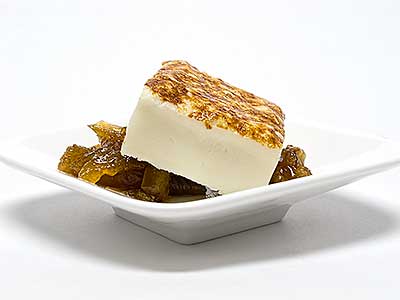May 27, 2013
Amuse-Bouche

fromage frit
(fried cheese)
My love of cheese started during the third week of October, 1999. I was at the Michelin one-star restaurant Hostellerie de Vieux Moulin in Bouilland, France. Before the dessert was served, the cheese trolley, or chariot à fromages, was wheeled to the table. This was no simple cart with a small platter of cheese. The trolley was almost two meters (six feet) long and was topped with two shelves, both of which were filled with a variety of cheeses. After a full week of eating at the restaurant and having a double helping of cheese each meal, I zeroed in on my absolute favorite, Mont d’Or.
Mont d’Or, or as it’s sometimes called, Vacherin du Haut-Doubs, is a French, cow’s milk cheese made in the Jura during the winter months by a small number of producers. It’s best eaten when it is fully ripe. The wheel comes in a wooden box. The top rind, which has the appearance of a piece of cream-colored flannel, is pierced with a spoon, and the very soft, white interior dolloped onto a plate. The cheese is served from the wooden box.
I’ve not eaten this same cheese in the United States. I’ve talked with various suppliers and received various excuses, but no cheese. But this cheese, and the others on the trolley, made me aware of the possibilities in the world of cheese. This was a different world than four decades earlier when cheese to me meant processed American cheese. My parents also ate Swiss, mild cheddars, and Monterey Jack. For spaghetti there was Parmesan cheese in a green, cardboard tube. Other types of cheeses just weren’t available without venturing into ethic neighborhoods and ethnic markets, something not often done in my family.
Nowadays, hundreds, if not more, cheese varieties are available in the various gourmet markets in my area. The region is also ripe with a number of world-class, artisan cheese makers. So last January, as I was into hour seven of walking the aisles of the Winter Fancy Food Show in San Francisco and seeing hundreds of cheeses, I almost didn’t stop to taste and learn about juustoleipä. I learned that this cheese originally was from Finland, and that its name translates into “bread cheese.” The cheese sample that Jay Noble, the producer, handed me was warm. The pieced was browned on the outside and silky smooth, but slightly firm, on the inside. It was very nice. I chatted with him briefly, took a piece of literature, ate a few more juustoleipä samples, and wrote “baked⁄grilled cheese” in my amuse-bouche idea⁄note list.
This wasn’t the first time I encountered cheese that didn’t melt, but it was the first time I wondered why. After finding a mish-mash of answers on the Internet and doing no better with the two cheesemongers I asked, both of whom got the answer wrong, I did what I should have done first. I consulted McGee’s On Food and Cooking. His answer? Acid. Or rather that cheeses that were reluctant to melt when heated were curdled with an acid. Most cheeses are curdled with rennet, and most of that cheese melts.
Listed as an example of acid-curdled cheese was queso blanco, a semi-hard cheese of Mexican origins. Here was a cheese that was readily available in my area at a low cost. What could be better? On my next trip to the market, I found a nice, vacuum-packed, factory-produced sample, and bought it.
When I returned from the market, I set a small, dry frying pan over high heat and proceeded to empty my grocery bags. I unwrapped the cheese and cut off a square from the block. I placed the piece on the now hot frying pan. After a short delay, the surface in contact with the pan started to bubble and melt. The whole square didn’t melt, just the portion in direct contact with the hot surface. I flipped the cheese square and found that the cooked surface was a pleasant, mottled, brown color. After cooking the second side, I did an immediate taste test. It was good, but not ready for prime time. The melted surface had mushroomed. This left the cut edge a bit sloppy. And although the heat enhanced the mild, slightly salty taste of the queso blanco, it was still too plain.
Earlier in the day, I had been reading a recipe for making a blackberry-chili syrup. Not having any immediately at hand, I cooked up a second piece of cheese and tried it with some black currant syrup, which I did have as hand. The sweetness offset the saltiness very nicely, but the syrup would be difficult to control on a plate. Digging deep into my refrigerator, I found a small mason jar with a few dabs of Meyer-lemon marmalade that I made years ago. It was a little oxidized, but it still tasted fine. While the refrigerator door was open, I finished putting away my groceries.
When I finally served the cheese as an amuse-bouche, I made a slight change in the preparation. Rather than cutting the cheese into individual serving pieces before cooking, I cut a single piece that was larger than needed. After frying, a narrow slice was removed from each melted edge to produce a clean looking block, and the block was cut into individual serving pieces. Served with the marmalade, the taste was sweet, salty and good.
© 2013 Peter Hertzmann. All rights reserved.
